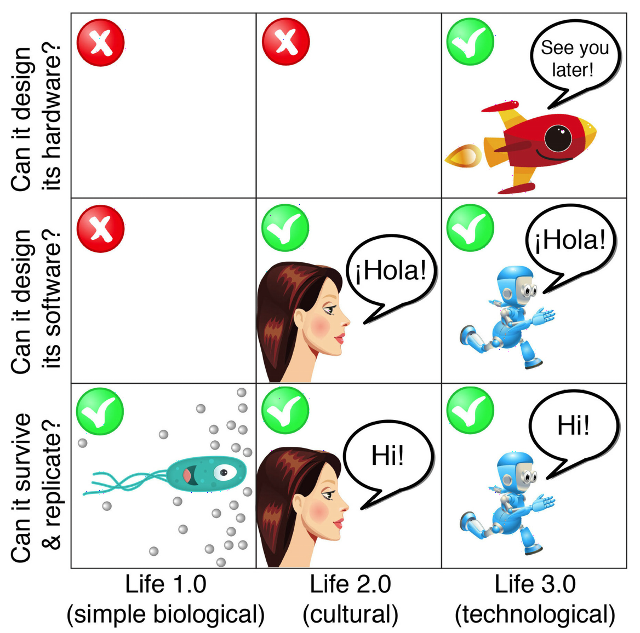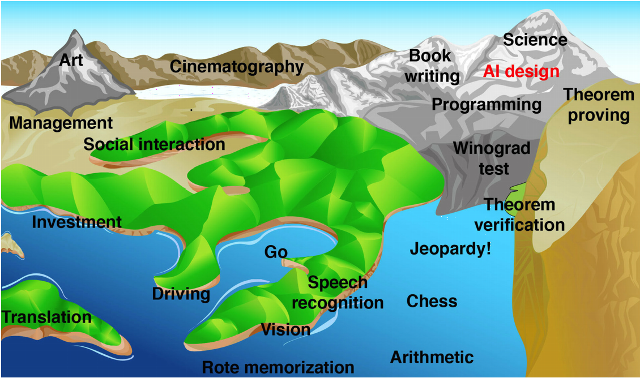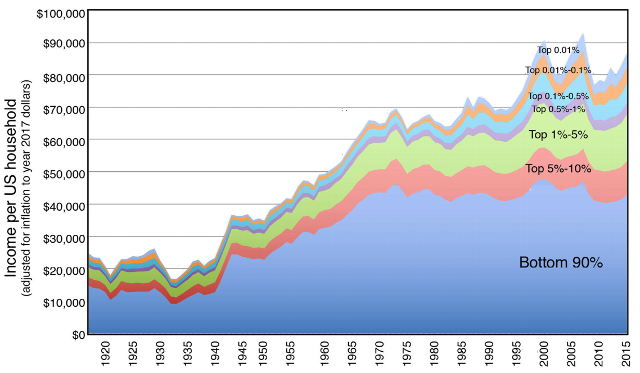« February 1, 2018 | Main | February 10, 2018 »
Sunday, February 4, 2018
Reading List: Life 3.0
- Tegmark, Max. Life 3.0. New York: Alfred A. Knopf, 2017. ISBN 978-1-101-94659-6.
-
The Earth formed from the protoplanetary disc surrounding the
young Sun around 4.6 billion years ago. Around one hundred
million years later, the nascent planet, beginning to solidify,
was clobbered by a giant impactor which ejected the mass that
made the Moon. This impact completely re-liquefied the Earth and
Moon. Around 4.4 billion years ago, liquid water appeared on
the Earth's surface (evidence for this comes from
Hadean
zircons which date from this era).
And, some time thereafter, just about as soon as the Earth
became environmentally hospitable to life (lack of disruption
due to bombardment by comets and asteroids, and a temperature
range in which the chemical reactions of life can proceed),
life appeared. In speaking of the origin of life, the evidence
is subtle and it's hard to be precise. There is completely
unambiguous evidence of life on Earth 3.8 billion years ago, and
more subtle clues that life may have existed as early as 4.28
billion years before the present. In any case, the Earth has
been home to life for most of its existence as a planet.
This was what the author calls “Life 1.0”. Initially
composed of single-celled organisms (which, nonetheless, dwarf
in complexity of internal structure and chemistry anything
produced by other natural processes or human technology to this
day), life slowly diversified and organised into colonies of
identical cells, evidence for which can be seen in
rocks
today.
About half a billion years ago, taking advantage of the far more
efficient metabolism permitted by the oxygen-rich atmosphere
produced by the simple organisms which preceded them, complex
multi-cellular creatures sprang into existence in the
“Cambrian
explosion”. These critters manifested all
the body forms found today, and every living being traces
its lineage back to them. But they were still Life 1.0.
What is Life 1.0? Its key characteristics are that it can
metabolise and reproduce, but that it can learn only
through evolution. Life 1.0, from bacteria through insects,
exhibits behaviour which can be quite complex, but that
behaviour can be altered only by the random variation of
mutations in the genetic code and natural selection of
those variants which survive best in their environment. This
process is necessarily slow, but given the vast expanses of
geological time, has sufficed to produce myriad species,
all exquisitely adapted to their ecological niches.
To put this in present-day computer jargon, Life 1.0 is
“hard-wired”: its hardware (body plan and metabolic
pathways) and software (behaviour in response to stimuli) are
completely determined by its genetic code, and can be altered
only through the process of evolution. Nothing an organism
experiences or does can change its genetic programming: the
programming of its descendants depends solely upon its success
or lack thereof in producing viable offspring and the luck of
mutation and recombination in altering the genome they inherit.
Much more recently, Life 2.0 developed. When? If you want
to set a bunch of paleontologists squabbling, simply ask them
when learned behaviour first appeared, but some time between
the appearance of the first mammals and the ancestors of
humans, beings developed the ability to learn from
experience and alter their behaviour accordingly. Although
some would argue simpler creatures (particularly
birds)
may do this, the fundamental hardware which seems to enable
learning is the
neocortex,
which only mammalian brains possess. Modern humans are the
quintessential exemplars of Life 2.0; they not only learn from
experience, they've figured out how to pass what they've learned
to other humans via speech, writing, and more recently, YouTube
comments.
While Life 1.0 has hard-wired hardware and software, Life 2.0 is
able to alter its own software. This is done by training the
brain to respond in novel ways to stimuli. For example, you're
born knowing no human language. In childhood, your brain
automatically acquires the language(s) you hear from those
around you. In adulthood you may, for example, choose to learn
a new language by (tediously) training your brain to understand,
speak, read, and write that language. You have deliberately
altered your own software by reprogramming your brain, just as
you can cause your mobile phone to behave in new ways by
downloading a new application. But your ability to change
yourself is limited to software. You have to work with the
neurons and structure of your brain. You might wish to have
more or better memory, the ability to see more colours (as some
insects do), or run a sprint as fast as the current Olympic
champion, but there is nothing you can do to alter those
biological (hardware) constraints other than hope, over many
generations, that your descendants might evolve those
capabilities. Life 2.0 can design (within limits) its software,
but not its hardware.
The emergence of a new major revision of life is a big
thing. In 4.5 billion years, it has only happened twice,
and each time it has remade the Earth. Many technologists
believe that some time in the next century (and possibly
within the lives of many reading this review) we may see
the emergence of Life 3.0. Life 3.0, or Artificial
General Intelligence (AGI), is machine intelligence,
on whatever technological substrate, which can perform
as well as or better than human beings, all of the
intellectual tasks which they can do. A Life 3.0 AGI
will be better at driving cars, doing scientific research,
composing and performing music, painting pictures,
writing fiction, persuading humans and other AGIs to
adopt its opinions, and every other task including,
most importantly, designing and building ever more capable
AGIs. Life 1.0 was hard-wired; Life 2.0 could alter its
software, but not its hardware; Life 3.0 can alter both
its software and hardware. This may set off an
“intelligence
explosion” of recursive
improvement, since each successive generation of AGIs will be
even better at designing more capable successors, and this cycle
of refinement will not be limited to the glacial timescale of
random evolutionary change, but rather an engineering cycle
which will run at electronic speed. Once the AGI train pulls
out of the station, it may develop from the level of human
intelligence to something as far beyond human cognition as
humans are compared to ants in one human sleep cycle. Here is a
summary of Life 1.0, 2.0, and 3.0.
The emergence of Life 3.0 is something about which we, exemplars of Life 2.0, should be concerned. After all, when we build a skyscraper or hydroelectric dam, we don't worry about, or rarely even consider, the multitude of Life 1.0 organisms, from bacteria through ants, which may perish as the result of our actions. Might mature Life 3.0, our descendants just as much as we are descended from Life 1.0, be similarly oblivious to our fate and concerns as it unfolds its incomprehensible plans? As artificial intelligence researcher Eliezer Yudkowsky puts it, “The AI does not hate you, nor does it love you, but you are made out of atoms which it can use for something else.” Or, as Max Tegmark observes here, “[t]he real worry isn't malevolence, but competence”. It's unlikely a super-intelligent AGI would care enough about humans to actively exterminate them, but if its goals don't align with those of humans, it may incidentally wipe them out as it, for example, disassembles the Earth to use its core for other purposes. But isn't this all just science fiction—scary fairy tales by nerds ungrounded in reality? Well, maybe. What is beyond dispute is that for the last century the computing power available at constant cost has doubled about every two years, and this trend shows no evidence of abating in the near future. Well, that's interesting, because depending upon how you estimate the computational capacity of the human brain (a contentious question), most researchers expect digital computers to achieve that capacity within this century, with most estimates falling within the years from 2030 to 2070, assuming the exponential growth in computing power continues (and there is no physical law which appears to prevent it from doing so). My own view of the development of machine intelligence is that of the author in this “intelligence landscape”.
Altitude on the map represents the difficulty of a cognitive task. Some tasks, for example management, may be relatively simple in and of themselves, but founded on prerequisites which are difficult. When I wrote my first computer program half a century ago, this map was almost entirely dry, with the water just beginning to lap into rote memorisation and arithmetic. Now many of the lowlands which people confidently said (often not long ago), “a computer will never…”, are submerged, and the ever-rising waters are reaching the foothills of cognitive tasks which employ many “knowledge workers” who considered themselves safe from the peril of “automation”. On the slope of Mount Science is the base camp of AI Design, which is shown in red since when the water surges into it, it's game over: machines will now be better than humans at improving themselves and designing their more intelligent and capable successors. Will this be game over for humans and, for that matter, biological life on Earth? That depends, and it depends upon decisions we may be making today. Assuming we can create these super-intelligent machines, what will be their goals, and how can we ensure that our machines embody them? Will the machines discard our goals for their own as they become more intelligent and capable? How would bacteria have solved this problem contemplating their distant human descendants? First of all, let's assume we can somehow design our future and constrain the AGIs to implement it. What kind of future will we choose? That's complicated. Here are the alternatives discussed by the author. I've deliberately given just the titles without summaries to stimulate your imagination about their consequences.
- Libertarian utopia
- Benevolent dictator
- Egalitarian utopia
- Gatekeeper
- Protector god
- Enslaved god
- Conquerors
- Descendants
- Zookeeper
- 1984
- Reversion
- Self-destruction
I'm not sure this chart supports the argument that technology has been the principal cause for the stagnation of income among the bottom 90% of households since around 1970. There wasn't any major technological innovation which affected employment that occurred around that time: widespread use of microprocessors and personal computers did not happen until the 1980s when the flattening of the trend was already well underway. However, two public policy innovations in the United States which occurred in the years immediately before 1970 (1, 2) come to mind. You don't have to be an MIT cosmologist to figure out how they torpedoed the rising trend of prosperity for those aspiring to better themselves which had characterised the U.S. since 1940. Nonetheless, what is coming down the track is something far more disruptive than the transition from an agricultural society to industrial production, and it may happen far more rapidly, allowing less time to adapt. We need to really get this right, because everything depends on it. Observation and our understanding of the chemistry underlying the origin of life is compatible with Earth being the only host to life in our galaxy and, possibly, the visible universe. We have no idea whatsoever how our form of life emerged from non-living matter, and it's entirely possible it may have been an event so improbable we'll never understand it and which occurred only once. If this be the case, then what we do in the next few decades matters even more, because everything depends upon us, and what we choose. Will the universe remain dead, or will life burst forth from this most improbable seed to carry the spark born here to ignite life and intelligence throughout the universe? It could go either way. If we do nothing, life on Earth will surely be extinguished: the death of the Sun is certain, and long before that the Earth will be uninhabitable. We may be wiped out by an asteroid or comet strike, by a dictator with his fat finger on a button, or by accident (as Nathaniel Borenstein said, “The most likely way for the world to be destroyed, most experts agree, is by accident. That's where we come in; we're computer professionals. We cause accidents.”). But if we survive these near-term risks, the future is essentially unbounded. Life will spread outward from this spark on Earth, from star to star, galaxy to galaxy, and eventually bring all the visible universe to life. It will be an explosion which dwarfs both its predecessors, the Cambrian and technological. Those who create it will not be like us, but they will be our descendants, and what they achieve will be our destiny. Perhaps they will remember us, and think kindly of those who imagined such things while confined to one little world. It doesn't matter; like the bacteria and ants, we will have done our part. The author is co-founder of the Future of Life Institute which promotes and funds research into artificial intelligence safeguards. He guided the development of the Asilomar AI Principles, which have been endorsed to date by 1273 artificial intelligence and robotics researchers. In the last few years, discussion of the advent of AGI and the existential risks it may pose and potential ways to mitigate them has moved from a fringe topic into the mainstream of those engaged in developing the technologies moving toward that goal. This book is an excellent introduction to the risks and benefits of this possible future for a general audience, and encourages readers to ask themselves the difficult questions about what future they want and how to get there. In the Kindle edition, everything is properly linked. Citations of documents on the Web are live links which may be clicked to display them. There is no index.